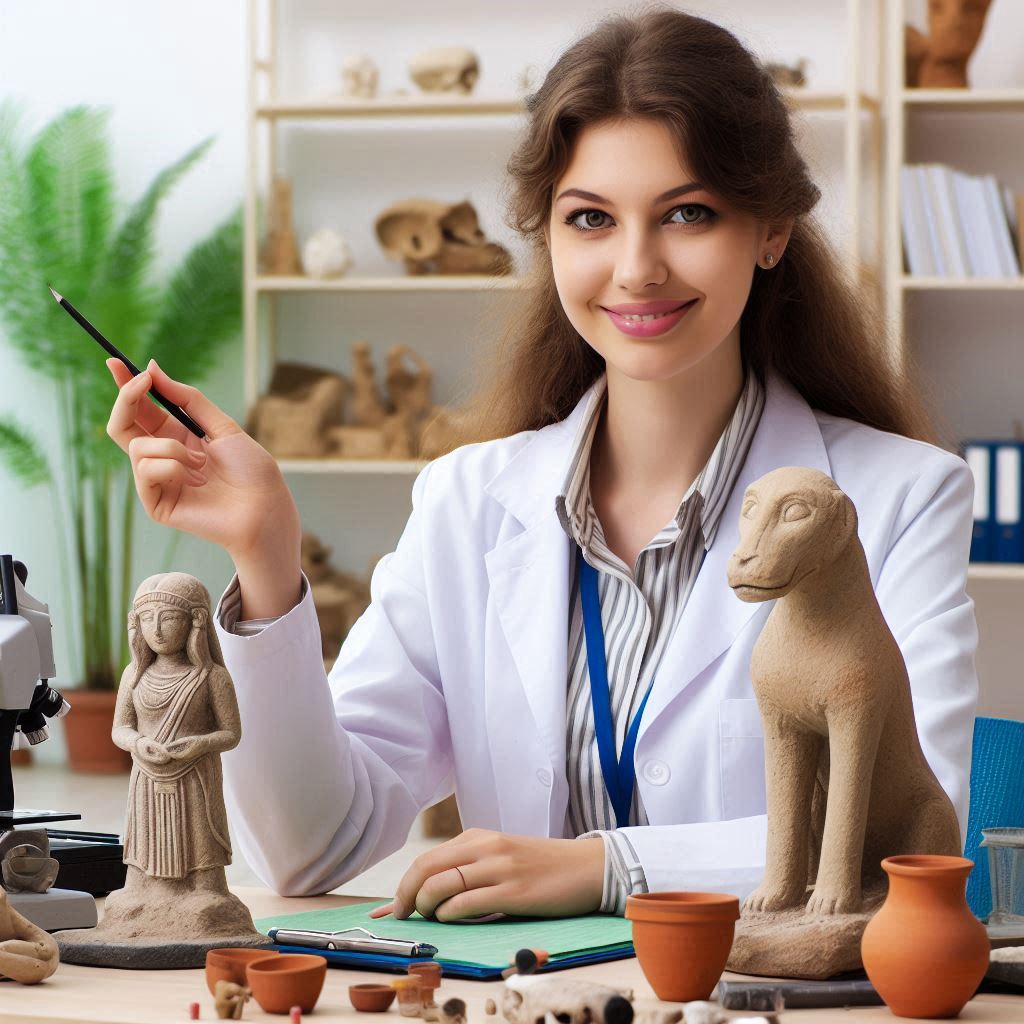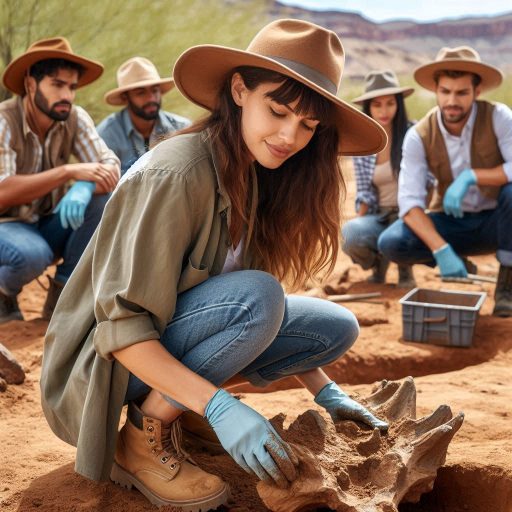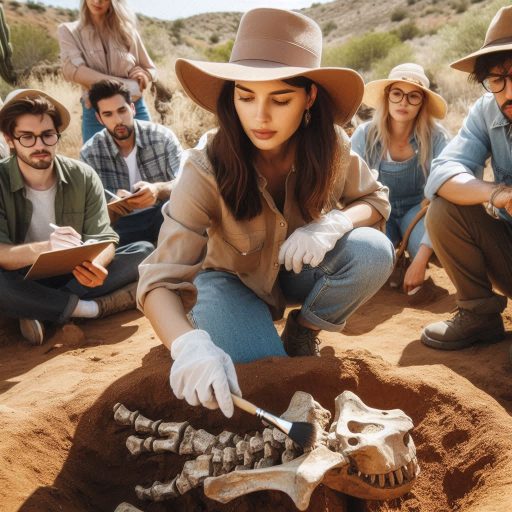Introduction
Archaeologists play a vital role in contributing to science and research.
They explore ancient sites and analyze artifacts to uncover human history.
Through their work, they provide valuable insights into past cultures and civilizations.
Archaeology helps us understand the complexities of human development over time.
It sheds light on how societies evolved, interacted, and adapted to their environments.
By studying material remains, archaeologists reconstruct past lives and cultural practices.
This discipline intersects with various scientific fields, enriching our understanding of humanity.
Archaeologists employ advanced technologies and methodologies to gather data, ensuring accurate interpretations.
Their findings help bridge the gap between the past and present, informing our knowledge of human behavior.
Additionally, archaeology preserves cultural heritage for future generations.
By safeguarding ancient sites and artifacts, archaeologists ensure that history remains accessible.
This commitment to preservation fosters appreciation for diverse cultures and histories.
Archaeologists contribute significantly to science and research.
Their work is essential for understanding human history and culture.
As they continue to investigate and interpret the past, they enrich our collective knowledge and appreciation of humanity’s journey.
Overview of archaeology as a scientific discipline
What archaeology is and explain how it differs from other scientific fields
Archaeology is a scientific discipline that studies past human societies through material remains.
It seeks to understand cultural evolution, social structures, and historical contexts.
Unlike history, which relies on written records, archaeology examines physical evidence left behind.
This evidence includes artifacts, architecture, and environmental data.
Archaeology differs from other scientific fields, such as anthropology and geology, by its specific focus.
While anthropology studies contemporary human behavior and cultures, archaeology investigates past societies.
Geology examines the Earth’s physical structure and processes, while archaeology interprets how people interacted with their environments over time.
Methodologies and techniques used by archaeologists in their research
Archaeologists employ various methodologies to conduct their research.
One primary method is excavation, which involves systematically removing soil layers to uncover artifacts.
Excavation allows archaeologists to study the context of findings, helping them interpret their significance.
Stratigraphy is another important technique.
It analyzes the layering of soil and artifacts to establish chronological relationships.
In addition to excavation, archaeologists use survey techniques to identify potential sites.
Surveys involve systematically walking through landscapes to document surface artifacts and features.
This process helps archaeologists locate areas of interest for further investigation.
Remote sensing technology, such as ground-penetrating radar, aids in detecting subsurface features without excavation.
Archaeologists also apply scientific techniques to analyze artifacts and ecofacts.
For instance, radiocarbon dating helps determine the age of organic materials.
This technique measures the decay of carbon isotopes in once-living organisms.
Other methods, such as dendrochronology and thermoluminescence, provide further insights into dating artifacts.
Material analysis plays a significant role in archaeology.
Scientists analyze pottery, tools, and other artifacts to determine their composition.
This analysis reveals information about the materials used and the manufacturing techniques employed.
Understanding these aspects can shed light on trade networks and technological advancements in past societies.
Archaeologists often collaborate with experts from various fields, such as geology, biology, and chemistry.
These collaborations enhance the scientific rigor of archaeological research.
By integrating multiple disciplines, archaeologists gain a deeper understanding of the past.
Archaeology is a unique scientific discipline focused on understanding human history through material remains.
Its methodologies, including excavation, survey techniques, and scientific analysis, distinguish it from other fields.
Role of Archaeologists in Studying Ancient Civilizations
How archaeologists unearth and analyze artifacts to better understand ancient cultures
Archaeologists play a crucial role in studying ancient civilizations.
They unearth and analyze artifacts to understand past cultures better.
This process begins with careful excavation, where archaeologists systematically remove soil layers.
Each layer can reveal valuable information about the period it represents.
After excavation, archaeologists catalog and document the artifacts.
They record details such as the location, depth, and condition of each item.
This information helps them establish context, which is vital for interpretation.
Context allows archaeologists to understand how artifacts were used and what they signify within their cultural framework.
One significant aspect of analyzing artifacts is identifying their functions.
For instance, pottery shards can indicate dietary practices and trade relationships.
Tools made from stone or metal reveal technological advancements and resource utilization.
By examining these objects, archaeologists can piece together the daily lives of ancient peoples.
Example of Significant Discoveries
One notable discovery is the tomb of Tutankhamun in Egypt.
Discovered by Howard Carter in 1922, the tomb contained a wealth of artifacts.
These artifacts, including gold jewelry and intricate furnishings, provided insights into ancient Egyptian burial practices.
The discovery also highlighted the wealth and power of pharaohs during that period.
Another significant find is the ancient city of Pompeii in Italy.
Buried under volcanic ash in 79 AD, Pompeii offers a snapshot of Roman life.
Excavations have uncovered homes, streets, and public buildings.
Artifacts such as frescoes, tools, and everyday items reveal social structures and cultural norms.
The Terracotta Army, found near the tomb of China’s first emperor, Qin Shi Huang, is another vital discovery.
This collection of over 8,000 life-sized statues dates back to the 3rd century BC.
The army represents the emperor’s quest for immortality and his belief in the afterlife.
Studying these artifacts helps historians understand ancient Chinese beliefs and military practices.
Archaeologists also analyze architectural remains to gain insights into ancient societies.
For instance, the ruins of Machu Picchu in Peru reveal the engineering skills of the Inca civilization.
The site’s layout, agricultural terraces, and water management systems demonstrate advanced planning and sustainability.
Archaeologists unearth and analyze artifacts to enhance our understanding of ancient cultures.
Significant discoveries, such as Tutankhamun’s tomb, Pompeii, and the Terracotta Army, provide invaluable insights into history.
Through meticulous excavation and analysis, archaeologists continue to uncover the complexities of human civilization and contribute to our knowledge of the past.
Read: The Future of Botany: Emerging Fields and Innovations
Archaeologists contribute to understanding of human evolution
Archaeologists play a vital role in understanding human evolution.
They use archaeological evidence to trace the development of humans and our ancestors.
This evidence includes fossils, tools, and other artifacts that provide insights into ancient lifestyles.
By analyzing these findings, archaeologists help create a timeline of human evolution.
Tracing Human Evolution
One way archaeologists trace evolution is through fossil records.
Fossils provide essential information about physical changes over time.
For example, discoveries of early hominids, such as Australopithecus afarensis, have shed light on human ancestry.
The famous fossil named “Lucy” dates back over 3 million years.
Her skeletal structure reveals adaptations for bipedalism, indicating a significant step in human evolution.
Additionally, archaeologists study ancient tools to understand cognitive development.
The Oldowan tool industry, dating back 2.6 million years, marks one of the earliest uses of stone tools.
These simple implements demonstrate early humans’ problem-solving abilities.
Over time, tools became more sophisticated, reflecting advances in technology and social organization.
Key Discoveries in Paleoanthropology
Several key discoveries in paleoanthropology have shaped our understanding of human evolution.
The Laetoli footprints, discovered in Tanzania, date back approximately 3.6 million years.
These footprints, believed to belong to Australopithecus afarensis, provide evidence of upright walking.
They illustrate the importance of bipedalism in human evolution.
The discovery of Homo habilis fossils further highlights human development.
This species, known as “handy man,” lived around 2.4 million years ago.
The fossils found in Tanzania show a larger brain size and the use of tools.
This advancement marks a significant shift in cognitive abilities and adaptability.
Another crucial find is the Homo neanderthalensis species, commonly known as Neanderthals.
Neanderthal remains have been discovered across Europe and Asia.
Their unique features, such as robust builds and large skulls, provide insights into their way of life.
Archaeologists also found evidence of tool-making and burial practices among Neanderthals, suggesting complex social behaviors.
The discovery of Homo sapiens fossils in Morocco, dating back around 300,000 years, has redefined human origins.
These fossils exhibit characteristics similar to modern humans, challenging previous theories about when Homo sapiens first emerged.
This finding highlights the complexity of human evolution and the need for ongoing research.
Archaeologists significantly contribute to our understanding of human evolution.
By examining fossils, tools, and ancient footprints, they trace the development of humans and our ancestors.
Key discoveries, such as Lucy, the Laetoli footprints, and Neanderthal remains, continue to shape our understanding of human evolution.
Through their work, archaeologists deepen our knowledge of humanity’s past and how we have evolved over millennia.
Read: What Does a Geologist Do? Career Overview and Insights
Importance of archaeologists in preserving cultural heritage
Archaeologists play a vital role in preserving cultural heritage.
They work to protect archaeological sites and ensure that significant artifacts remain intact.
Their efforts help maintain our connection to the past and provide insights into ancient civilizations.
Role of Archaeologists in Preservation
Archaeologists begin by documenting archaeological sites.
They record the location, features, and artifacts found at each site.
This documentation is crucial for future research and preservation efforts.
By creating detailed maps and reports, archaeologists establish a comprehensive record of cultural heritage.
Moreover, archaeologists often conduct excavations.
They carefully uncover artifacts and structures while minimizing damage to the site.
Each excavation provides valuable data about ancient cultures and their practices.
These findings contribute to our understanding of human history.
Archaeologists also advocate for the protection of archaeological sites.
They collaborate with local governments and organizations to develop preservation plans.
These plans may include regulations to prevent unauthorized excavations and construction.
By raising awareness of cultural significance, archaeologists promote the importance of safeguarding heritage.
Ethical Considerations in Archaeological Research
Ethics play a significant role in archaeological research and conservation efforts.
Archaeologists must consider the impact of their work on local communities and cultural traditions.
Engaging with local stakeholders is essential for ensuring responsible research practices.
Collaboration fosters mutual respect and enhances the preservation of cultural heritage.
Additionally, archaeologists face ethical dilemmas regarding artifact ownership.
They must navigate the complexities of cultural heritage laws and international agreements.
Respecting the wishes of local communities regarding artifacts is crucial.
Archaeologists should prioritize collaboration and transparency to foster trust.
The concept of repatriation also highlights ethical considerations.
Many artifacts reside in museums far from their original context.
Archaeologists advocate for returning these artifacts to their communities of origin.
Repatriation acknowledges the cultural significance of these items and promotes healing.
Furthermore, archaeologists must balance research with conservation.
They often face challenges in preserving fragile sites while conducting investigations.
Developing non-invasive techniques can help mitigate damage.
Methods like remote sensing and ground-penetrating radar allow for data collection without excavation.
Training and education are essential aspects of preservation efforts.
Archaeologists often organize workshops and outreach programs for local communities.
These initiatives raise awareness of the importance of preserving cultural heritage.
By empowering communities, archaeologists ensure a collaborative approach to conservation.
Archaeologists are crucial in preserving cultural heritage.
They document and excavate archaeological sites while advocating for their protection.
Ethical considerations guide their research practices and interactions with local communities.
By fostering collaboration and promoting education, archaeologists help ensure that cultural heritage remains intact for future generations.
Their work not only uncovers our past but also preserves it for the future.
Read: Educational Path: Becoming a Geologist in the USA

Archaeologists collaborate with other scientific disciplines
How archaeologists work with scientists from fields such as anthropology, geology, and biology
Archaeologists often collaborate with scientists from various fields.
This interdisciplinary approach enhances the understanding of past human behaviors and environments.
By combining expertise, they uncover new insights and broaden the scope of research.
Collaboration with Anthropology
Archaeologists frequently work with anthropologists.
Both disciplines focus on understanding human societies, though their methods differ.
Archaeologists rely on material remains, while anthropologists often study living cultures.
This partnership enriches research by connecting past and present human experiences.
For example, archaeologists and anthropologists might collaborate on a project about ancient trade routes.
By analyzing artifacts and cultural practices, they can reconstruct social networks.
This cooperation leads to a more comprehensive understanding of ancient societies and their interactions.
Collaboration with Geology
Geologists also play a crucial role in archaeological research.
They analyze soil samples and geological formations to understand site contexts.
This collaboration helps archaeologists determine the age of artifacts and the environmental conditions during specific periods.
In one notable project, archaeologists and geologists studied a prehistoric settlement.
They used geological surveys to assess the site’s potential for preservation.
The findings revealed how natural processes influenced human activities in the area.
Such interdisciplinary work provides critical insights into the relationship between humans and their environment.
Collaboration with Biology
Biologists contribute to archaeology through the study of ancient DNA and other biological materials.
They help archaeologists analyze plant and animal remains, offering insights into past diets and ecosystems.
This collaboration deepens the understanding of how ancient societies interacted with their environments.
A prominent example involves a joint project examining the remains of prehistoric crops.
By studying ancient pollen and seeds, biologists identified agricultural practices of early civilizations.
This research highlighted the role of agriculture in societal development and environmental change.
Interdisciplinary Research Projects
Interdisciplinary research projects often yield groundbreaking discoveries.
For instance, a collaborative study involving archaeology, anthropology, and genetics traced human migration patterns.
Researchers combined archaeological evidence with genetic data to map population movements over millennia.
This work reshaped our understanding of human evolution and dispersal.
Another successful interdisciplinary project involved climate science and archaeology.
Researchers studied sediment cores from lakes near archaeological sites.
By analyzing climate data alongside artifacts, they examined how climate changes influenced human settlement patterns.
This research emphasized the interconnectedness of environmental factors and human behavior.
Collaboration between archaeologists and other scientific disciplines fosters innovation and discovery.
By working with anthropologists, geologists, and biologists, archaeologists gain valuable insights into past societies.
Interdisciplinary research projects expand knowledge and reveal the complexities of human history.
This collaborative approach ultimately enriches the field of archaeology and enhances our understanding of the past.
Through teamwork, scientists continue to unveil the mysteries of human existence and cultural development.
Transform Your Career Today
Unlock a personalized career strategy that drives real results. Get tailored advice and a roadmap designed just for you.
Start NowRead: Botany Career Fairs and Networking Events
Archaeologists use technology in their research
Technology plays a crucial role in modern archaeological research.
It has transformed how archaeologists collect, analyze, and interpret data.
Innovative tools enhance their ability to explore ancient sites and artifacts.
Impact of technology on archaeological research, such as LiDAR scanning and 3D printing
Impact of LiDAR Scanning
LiDAR (Light Detection and Ranging) scanning revolutionizes archaeological survey techniques.
This technology uses laser light to create detailed 3D maps of landscapes.
It penetrates vegetation, revealing hidden structures and features.
For example, LiDAR has uncovered ancient cities in dense jungles.
Researchers discovered Mayan cities in Guatemala that were previously invisible.
These findings have reshaped our understanding of ancient urban planning and development.
Advancements in 3D Printing
3D printing also significantly impacts archaeology.
Archaeologists can create accurate replicas of artifacts using 3D printers.
This process allows researchers to study objects without risking damage to originals.
For instance, a team could print a replica of a fragile pottery shard.
Researchers can analyze the replica while preserving the original artifact.
This method promotes collaboration and sharing among museums and institutions.
Geographic Information Systems (GIS)
Geographic Information Systems (GIS) enhance data analysis in archaeology.
GIS allows archaeologists to map and analyze spatial relationships among artifacts and features.
This tool helps identify patterns and trends across large datasets.
GIS has been instrumental in studying ancient trade routes.
By mapping the locations of artifacts, archaeologists can understand trade dynamics.
This approach reveals how ancient societies interacted and exchanged goods.
Drones and Aerial Photography
Drones have transformed archaeological site documentation.
They capture high-resolution aerial images, providing a comprehensive view of landscapes.
Drones allow archaeologists to survey large areas quickly and efficiently.
For example, researchers use drones to map archaeological sites before excavation.
Aerial imagery reveals site layouts and spatial relationships.
This information aids in planning excavation strategies and protecting vulnerable areas.
Remote Sensing Technologies
Remote sensing technologies, like ground-penetrating radar (GPR), also enhance archaeological research.
GPR allows archaeologists to visualize subsurface features without excavation.
This technique helps identify potential excavation sites and understand site stratigraphy.
By using GPR, archaeologists can detect buried walls, ditches, and other structures.
This non-invasive method saves time and reduces site disturbance.
It also minimizes the environmental impact of archaeological research.
Data Analysis and Interpretation
Technology also aids in data analysis and interpretation.
Advanced software tools allow archaeologists to analyze large datasets quickly.
This capability enhances their ability to draw conclusions and make connections among findings.
For example, researchers can use machine learning algorithms to classify artifacts.
These tools improve efficiency in cataloging and analyzing large collections.
By automating repetitive tasks, archaeologists can focus on more complex analyses.
How New Technologies Have Revolutionized the Way Archaeologists Collect, Analyze, and Interpret Data
Technology profoundly impacts archaeological research methods and practices.
Tools like LiDAR scanning, 3D printing, GIS, drones, and remote sensing have revolutionized the field.
These innovations enhance data collection, analysis, and interpretation, leading to new discoveries.
As technology continues to advance, archaeologists will gain even greater insights into the past.
Embracing these tools allows them to explore previously inaccessible areas and uncover hidden histories.
Ultimately, technology will shape the future of archaeology, expanding our understanding of ancient cultures and societies.
Challenges faced by archaeologists in their work
Archaeologists face various challenges in their work.
Funding, site preservation, and ethical dilemmas often hinder archaeological research.
Addressing these challenges is crucial for the field’s growth and sustainability.
Challenges of Funding, Site Preservation, and Ethical Dilemmas in Archaeological Research
Funding Issues
One major challenge is securing adequate funding for archaeological projects.
Many researchers rely on grants, which can be highly competitive.
Limited financial resources restrict the scope and scale of research initiatives.
Insufficient funding often results in shorter excavation seasons.
Archaeologists may not collect all the data necessary for thorough analysis.
Consequently, important discoveries may go unexplored, leading to incomplete narratives about past cultures.
Site Preservation Challenges
Site preservation poses another significant challenge.
Many archaeological sites face threats from urban development, agriculture, and climate change.
These factors can lead to irreversible damage to valuable historical sites.
Archaeologists often struggle to balance research needs with preservation efforts.
Excavating sites without proper safeguards can compromise their integrity.
Protecting these sites while conducting research requires careful planning and resources.
Ethical Dilemmas
Ethical dilemmas also arise in archaeological research.
Archaeologists must navigate issues related to cultural heritage, ownership, and repatriation.
These dilemmas often involve sensitive negotiations with local communities and indigenous groups.
For instance, determining ownership of artifacts can be contentious.
Archaeologists must respect the cultural significance of these items to communities.
Failing to do so can damage relationships and hinder future collaboration.
Importance of Public Engagement and Awareness in Supporting Archaeological Projects
Public engagement is vital in overcoming these challenges.
Raising awareness about the importance of archaeology can foster support for funding and preservation efforts.
Engaging the public creates advocates for archaeological research and conservation.
Effective communication helps bridge the gap between archaeologists and the community.
Archaeologists can host workshops, lectures, and site tours to share their findings.
These initiatives build interest in archaeological work and encourage community involvement.
Support from Local Communities
Local communities play a crucial role in supporting archaeological projects.
Their involvement can lead to increased funding and resources.
Community members often have valuable knowledge about local history and culture.
Building relationships with local stakeholders can enhance project success.
Archaeologists can incorporate local insights into their research, leading to more comprehensive findings.
Collaborative efforts foster a sense of ownership and pride in local heritage.
Collaborating with Organizations
Archaeologists can also collaborate with organizations that advocate for cultural heritage preservation.
Nonprofits and governmental bodies often provide resources and support for archaeological projects.
Partnering with these organizations can increase visibility and funding opportunities.
Working together enhances the effectiveness of archaeological research.
By joining forces, archaeologists can address challenges related to site preservation and funding.
These collaborations can lead to innovative solutions and greater public awareness.
Archaeologists face significant challenges in their work.
Funding shortages, site preservation issues, and ethical dilemmas complicate research efforts.
Public engagement and collaboration with local communities are essential for overcoming these obstacles.
By fostering awareness and support, archaeologists can ensure the future of their work.
Ultimately, addressing these challenges is crucial for preserving our shared cultural heritage.
Conclusion
Archaeologists play a crucial role in advancing scientific knowledge and preserving cultural heritage.
They study ancient civilizations, uncovering artifacts that reveal insights into past societies.
Their work helps us understand human evolution through archaeological evidence and significant discoveries.
Technology has transformed archaeology, enhancing data collection and analysis.
Tools like LiDAR scanning and 3D printing enable archaeologists to document and replicate artifacts without damage.
Geographic Information Systems (GIS) allow them to analyze spatial relationships, uncovering trade routes and interaction patterns.
Archaeologists collaborate with various scientific disciplines, enriching their research and expanding knowledge across fields.
They address challenges in funding, preservation, and ethics while advocating for public engagement.
Through these efforts, archaeologists not only contribute to our understanding of history but also protect our cultural heritage for future generations.
Their work ensures that valuable insights are preserved and shared with the public.
In summary, archaeologists bridge the past and present, making significant contributions to science and society.
Their research fosters appreciation for diverse cultures and the complexities of human history.
As they continue to explore and innovate, archaeologists will remain vital in shaping our understanding of the world.
[E-Books for Sale]
The Big Book of 500 High-Paying Jobs in America: Unlock Your Earning Potential
$19.99 • 500 High-Paying Jobs • 330 pages
Explore 500 high-paying jobs in America and learn how to boost your career, earn more, and achieve success!
See All 500 High-Paying Jobs of this E-Book
1001 Professions Without a Degree: High-Paying American Jobs You Can Start Now
$19.99 • 1001 Professions Without a Degree • 174 pages
Discover 1001 high-paying jobs without a degree! Unlock career tips, skills, and success strategies for just $19.99!




